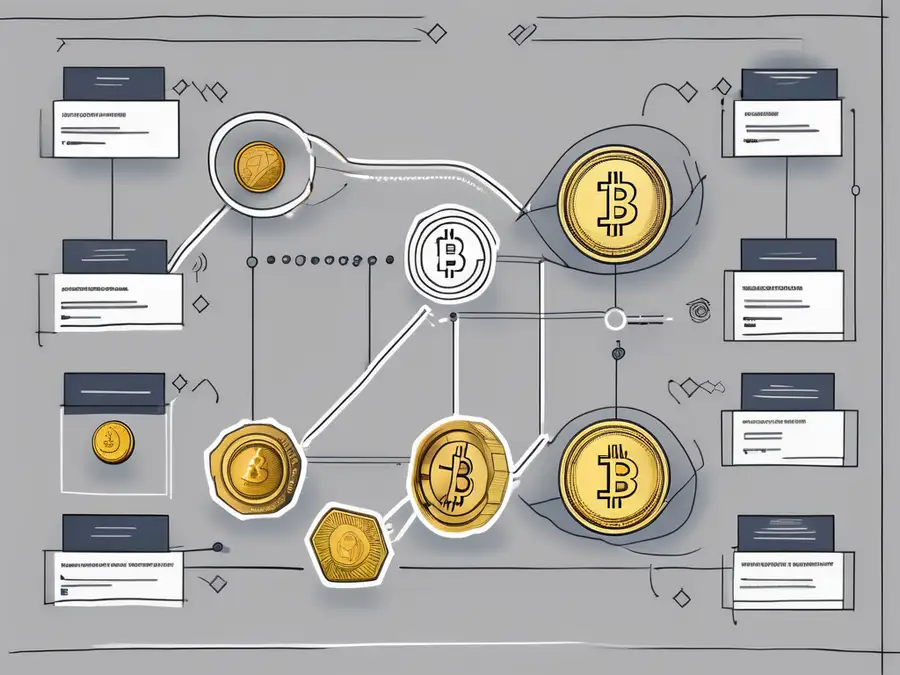Why UTXO Matters: The Backbone of Bitcoin Transactions

Cryptocurrencies have revolutionized how we perceive money and conduct transactions. Central to many cryptocurrencies is the UTXO (Unspent Transaction Output) model. This article delves deep into the UTXO model, exploring its intricacies, benefits, limitations, and recent market developments.
What is the UTXO Model?
The UTXO model, or Unspent Transaction Output model, is a foundational concept in cryptocurrency. It tracks the unspent outputs from previously conducted transactions, representing the state of an individual's digital wallet. Unlike traditional banking systems that use an account/balance model, the UTXO model maintains a list of individual outputs. These outputs, or UTXOs, serve as chunks of cryptocurrency that an individual owns, acting as proof of ownership and usable in future transactions.
UTXO Vs. Account/Balance Model
A key distinction between the UTXO model and the traditional account/balance model used by banks lies in how they track ownership. The account/balance model stores an individual's balance as a single value, while the UTXO model maintains a list of individual outputs. This distinction enhances security and privacy by preventing double-spending through the tracking of each UTXO. By ensuring each UTXO is used only once, the model effectively eliminates the risk of spending the same funds more than once. Additionally, the UTXO model offers improved privacy as it does not require linking user identities to specific transactions.
Transaction Flexibility and Security in UTXO
The UTXO model provides flexibility in handling transactions. Users can combine multiple UTXOs to meet the desired transaction amount, optimizing transaction fees by selecting appropriate UTXOs. This system ensures efficient transaction management and enhances the overall integrity of cryptocurrency transactions. Each UTXO represents a specific amount of cryptocurrency, allowing for precise control over transaction amounts. The cryptographic signature required for each transaction adds a layer of security, ensuring only the rightful owner can spend the UTXOs.
For example, during the 2023 Taproot upgrade for Bitcoin, the UTXO model was enhanced to support more complex transactions. Taproot allows multiple transaction types to be combined into a single UTXO, reducing the on-chain data size and increasing efficiency.
The Role of UTXO in Cryptocurrency
The UTXO model is crucial for ensuring transaction integrity and security in cryptocurrencies. It helps prevent double-spending and maintains a transparent record of all transactions on the blockchain. By creating a new UTXO for each transaction, the model ensures a clear, verifiable chain of ownership.
UTXO in Bitcoin
Bitcoin, the first and most popular cryptocurrency, heavily relies on the UTXO model. Each transaction consists of inputs (referencing UTXOs) and outputs (creating new UTXOs). This decentralized approach ensures security and transparency. The UTXO model in Bitcoin allows for improved privacy, as transactions don't link to specific identities. This anonymity attracts users seeking financial privacy and security.
UTXO in Other Cryptocurrencies
The UTXO model isn't limited to Bitcoin. Cryptocurrencies like Litecoin and Bitcoin Cash also utilize it for transaction validation and security. These altcoins benefit from the UTXO model's principles of transparency and decentralization. In Litecoin, a popular altcoin created by Charlie Lee, the UTXO model operates similarly to Bitcoin, ensuring the same level of security and decentralization. Bitcoin Cash, a fork of Bitcoin, maintains the UTXO model to uphold the principles of transparency and trustlessness in its transactions.
In 2022, Litecoin implemented the MimbleWimble extension block (MWEB), which leverages the UTXO model to provide confidential transactions. This upgrade allows users to send transactions with hidden amounts, enhancing privacy and security.
How the UTXO Model Works
The UTXO model operates on the principle that each transaction creates an output that can only be used as an input for future transactions. This system ensures transparency, security, and decentralization in the blockchain network. Transactions involve spending a portion of UTXOs and creating new UTXOs as outputs. When a transaction occurs, the spent UTXOs are removed from the system, and new UTXOs are generated as per the transaction's specifications.
Transaction Process and Verification
Every transaction in the UTXO model must be cryptographically signed by the owner of the UTXOs being spent, providing a secure way to transfer ownership. This signature is essential for validating the transaction and ensuring that only the rightful owner can spend the UTXOs. Inputs reference previously unspent UTXOs and act as proof of ownership, while outputs create new UTXOs that can be spent in future transactions. This model ensures that each transaction is verifiable by checking the validity of the inputs and outputs.
Benefits of the UTXO Model
The UTXO model brings several advantages to the table, primarily in terms of security, scalability, and performance.
Security
The UTXO model enhances security by making it difficult for malicious actors to manipulate transactions. As each UTXO represents a specific portion of the cryptocurrency, it becomes more difficult to tamper with. The transparency and verifiability of the UTXO model provide an added layer of security. Furthermore, the UTXO model's security benefits extend to privacy protection. Since each UTXO is discrete and does not require linking to a user's identity, it enhances anonymity in transactions. This feature is particularly appealing to users who prioritize privacy and confidentiality in their financial interactions.
Scalability and Performance
The UTXO model allows for improved scalability and performance in cryptocurrency networks. By dividing the digital wallet into individual UTXOs, the system can process transactions in parallel, enhancing efficiency and reducing transactional bottlenecks. This scalability feature is particularly valuable as cryptocurrencies continue to gain mainstream adoption. The UTXO model's design also contributes to network resilience. In the event of network congestion or high transaction volume, the UTXO model's parallel processing capability helps maintain smooth transaction flow without compromising on speed or reliability. This resilience is crucial for ensuring a consistent user experience, especially during periods of heightened network activity.
Challenges and Limitations of the UTXO Model
While the UTXO model offers several benefits, it is important to acknowledge its challenges and limitations.
Complexity and User Experience
Managing UTXOs can be complex and cumbersome, as each transaction involves selecting appropriate UTXOs. Users may find the process cumbersome, and managing UTXOs with varying denominations can make tracking and spending specific amounts of cryptocurrency challenging. Additionally, the UTXO model's design can lead to fragmented UTXOs, where a single transaction may result in multiple UTXOs of smaller denominations. This fragmentation can complicate the process of consolidating UTXOs and may lead to increased transaction fees due to larger transaction sizes.
During the 2021 rise in popularity of non-fungible tokens (NFTs) on the Ethereum network, which uses an account/balance model, the differences in transaction management became evident. The complexity of managing UTXOs versus a single balance in NFTs highlighted the need for user-friendly wallet solutions in UTXO-based systems.
Resource Consumption
The UTXO model consumes additional resources compared to the account/balance model. As each UTXO must be stored and verified, the overall computational and storage requirements for cryptocurrency networks using this model can be higher. The UTXO model's resource-intensive nature can impact scalability, especially during periods of high network activity. The need to store and process a large number of UTXOs can strain network nodes and potentially lead to slower transaction processing times.
During the 2021 Bitcoin bull run, network congestion led to increased transaction fees and slower confirmation times, highlighting the resource-intensive nature of the UTXO model. Solutions such as the Lightning Network, which processes transactions off-chain, were developed to alleviate some of these issues.
Conclusion
The UTXO model is a fundamental aspect of cryptocurrency, ensuring secure, transparent transactions. Understanding its intricacies and considering its benefits and limitations is crucial for anyone navigating digital currencies. Embracing the UTXO model opens up new horizons for the future of finance, empowering individuals with greater control and efficiency in their financial transactions.
As you explore the world of cryptocurrency and the UTXO model's role in ensuring secure and efficient transactions, consider enhancing your trading experience with Morpher. Embrace innovative trading with zero fees, infinite liquidity, and the safety of a non-custodial wallet. Whether you're interested in cryptocurrencies, stocks, forex, or even unique markets like NFTs, Morpher provides the tools for fractional investing, short selling, and up to 10x leverage to amplify your trades. Join Morpher today and revolutionize your trading journey.
FAQ
What is the UTXO model?
The UTXO model is a concept in cryptocurrency where each transaction creates new outputs, called Unspent Transaction Outputs (UTXOs), which act as chunks of cryptocurrency that individuals own.
How does the UTXO model differ from the account/balance model?
The UTXO model differs from the account/balance model by tracking individual UTXOs instead of a single value representing the individual's balance. This distinction enhances security and privacy in cryptocurrency transactions.
Which cryptocurrencies use the UTXO model?
The UTXO model is used in various cryptocurrencies, including Bitcoin, Litecoin, and Bitcoin Cash.
What are the benefits of the UTXO model?
The UTXO model offers enhanced security, scalability, and performance in cryptocurrency transactions.
What are the challenges of the UTXO model?
The UTXO model introduces complexity in managing digital wallets and consumes additional computational and storage resources compared to the account/balance model.
In conclusion, the UTXO model is a fundamental aspect of cryptocurrency, serving as the backbone for transaction validation, security, and transparency. Understanding its intricacies and considering its benefits and limitations is crucial for anyone navigating the world of digital currencies. Embracing the UTXO model opens up new horizons for the future of finance, empowering individuals with greater control and efficiency in their financial transactions.
As you explore the world of cryptocurrency and the UTXO model's role in ensuring secure and efficient transactions, consider taking your trading experience to the next level with Morpher. Embrace the future of investing on a platform that offers zero fees, infinite liquidity, and the safety of a non-custodial wallet. Whether you're interested in cryptocurrencies, stocks, forex, or even unique markets like NFTs, Morpher provides the tools for fractional investing, short selling, and up to 10x leverage to amplify your trades. Join the revolution at Morpher.com and transform your trading journey. Sign Up and Get Your Free Sign Up Bonus today to start trading with the innovation and flexibility that only Morpher can offer.

Disclaimer: All investments involve risk, and the past performance of a security, industry, sector, market, financial product, trading strategy, or individual’s trading does not guarantee future results or returns. Investors are fully responsible for any investment decisions they make. Such decisions should be based solely on an evaluation of their financial circumstances, investment objectives, risk tolerance, and liquidity needs. This post does not constitute investment advice.

Painless trading for everyone
Hundreds of markets all in one place - Apple, Bitcoin, Gold, Watches, NFTs, Sneakers and so much more.

Painless trading for everyone
Hundreds of markets all in one place - Apple, Bitcoin, Gold, Watches, NFTs, Sneakers and so much more.









